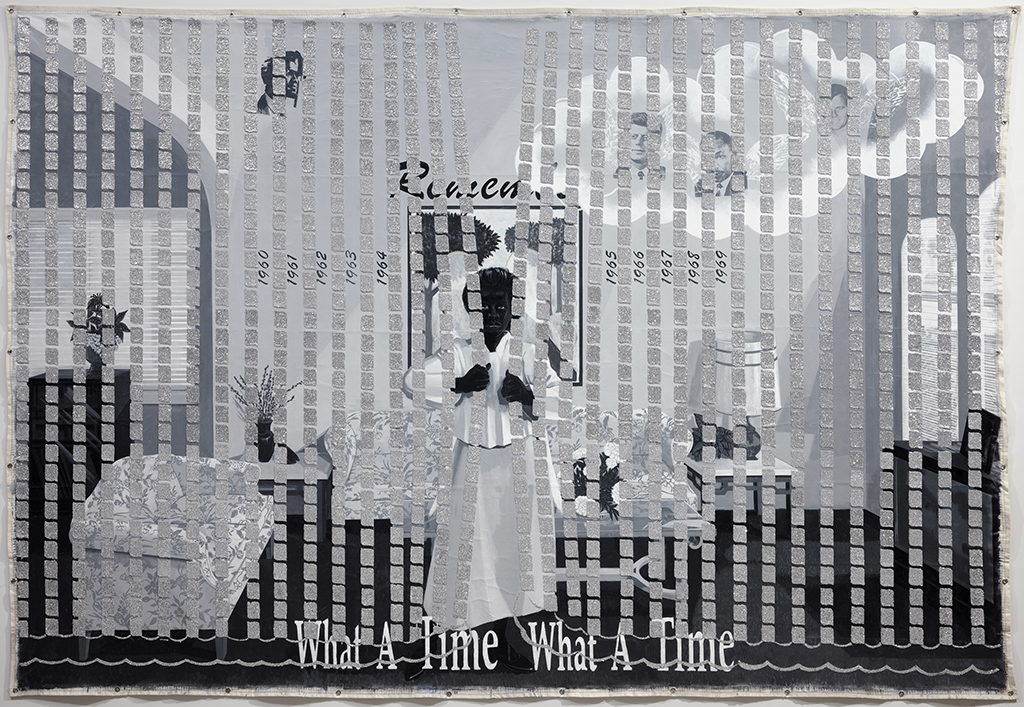Tour Overview
Outcomes
- Students will think critically about the power of works of art to advocate for social change.
- Students will engage in discussion of contemporary issues and historical events.
- Students will consider how artists show us perspectives outside the dominant narrative.
Content
Part 1: Kerry James Marshall – Students will explore Kerry James Marshall’s personal reflection on the Civil Rights Era in his work Memento #5 and learn about Marshall’s belief in the importance of representation.

Part 2: Class Choice — As a class, students will select one social issue to examine through art, either Racial Justice*; Colonialism and its Environmental Impact; or Labor Rights. They will analyze one work of art, learn about the context in which it was made, and evaluate its effectiveness as a tool for social change. If you would like to pre-select which social issue is discussed, please indicate your choice in the notes section of the request form. *Through March 27, 2022, classes that choose Racial Justice will have a chance to explore Kim Alexis Newton’s Embraced Promises in the featured exhibition Testimony: African American Artists Collective.
Curriculum
Visual Art:
- Perceive and analyze artistic work.
- Interpret intent and meaning in artistic work.
- Relate artistic ideas and works with societal, cultural, and historical context to deepen understanding.
History, Government, and Social Studies (KS):
- Investigate specific beliefs, contributions, ideas, and/ or diverse populations and connect those beliefs, contributions, ideas and/or diversity to contemporary issues.
- Investigate the relationship among people, places, ideas, and/or the environment and connect those relationships to contemporary issues.
Social Studies (MO):
- Using an American/world history lens, describe how peoples’ perspectives shaped the sources/artifacts they created.
- Trace the contributions of individuals and institutions on social, political, artistic and economic development.
- Analyze the varying process of colonization and decolonization to compare their impact on and legacies in the world today.
- Evaluate the short and long-term impact of western expansion on native populations.
- Analyze the changing relationship between individuals and their place in society including women, minorities, and children.
- Analyze political, social, cultural, artistic and economic revolutions to determine how they impacted concepts of class, race, tribe, slavery, and caste affiliation.
Before Your Tour
Preview the Featured Exhibition
Take some time to explore the featured exhibition Testimony: African American Artists Collective on the museum’s website here. If your class chooses the social issue of Racial Justice, they will discuss Kim Alexis Newton’s protest quilt Embraced Promises.
Explore Your Own Identity
Help students to learn about the many different facets that make up our identities. Guide them in understanding their own identities using the lesson plan and identity charts from Facing History here.
Representation in Popular Culture
Discuss representation in film and television as a class. Ask students to consider which aspects of their own identities they are easily able to find representations of in the media and popular culture they consume. Are there aspects of their own identities that are not as represented?
Recommended articles:
- Out of 30,000 Hollywood film characters, here’s how many weren’t white
- Film & TV Diversity: What Changed In 2019 And What’s Next In 2020
Watch Titus Kaphar’s Ted Talk
Invite students to watch artist Titus Kaphar’s Ted Talk from 2017 “Can Art Amend History?” Kaphar takes a paintbrush to a Frans Hals painting, bringing its hidden story into view.
After Your Tour
Learn More
Explore a virtual continuation of the Testimony exhibition featuring additional artists from the Kansas City-based African American Artists Collective here.
Check out our Teacher Guide for Testimony: African American Artists Collective exhibition here.
Sign Up for another Virtual School Program
Consider booking a virtual Curator for a Day workshop, which offers students the chance to try their hand at selecting a theme and finding connections between works of art from the exhibition.
Dig Deeper
Encourage students to explore the social issue (racial justice, colonialism and its environmental impact, or labor rights) they selected during the tour further by filling out the first two sections of a KWL chart (What do you know? and What do you want to know?). Students will use their “want to knows” to guide research on the topic. You might also wish to examine as a class the alternate work of art for the chosen social issue students did not discuss on the tour.
Suggested artworks:
Racial Justice:
- Kim Alexis Newton, Embraced Promises and other works of art from Testimony: African American Artists Collective
- Joseph Hirsh, Lynch Family
- Elizabeth Catlett, A Second Generation
Colonialism and its Environmental Impact:
- Shan Goshorn, Defending the Sacred
- Romuald Hazoumè, Fiozikpè, Azokouè, and First Lady
Labor Rights:
- Lewis Hine, Adolescent Spinner, Carolina Cotton Mill
- Alejandro Cartagena, Carpoolers
Glossary
- Colonialism: A system or policy by which a nation acquires full or partial political control over another country, territory or people, occupying it with settlers, and exploiting it economically
- Contemporary: Belonging to or occurring in the present
- Identity: The qualities, characteristics or beliefs that make a person who they are.
- Race: One of the major groups into which human beings can be divided. As a social construction, it relates to the grouping of people based on shared physical characteristics, such as skin color
- Representation: The portrayal of someone in a particular way or as being of a certain nature